Why a Digital Camera Makes Up for Your Phone’s Shortcomings
The camera market has changed a lot over the last decade. A once thriving market for point-and-shoot cameras has all but disappeared with the explosion of far more than competent cameras in your average smartphone. However, you may have seen one segment of the market that hasn’t quite disappeared. These are your digital SLR and mirrorless cameras, and with a wider range of options than ever before these cameras aren’t just for the professional photographers among us.
If you’ve ever wanted just a bit more from your family photos or found that your smartphone’s photos weren’t really getting the intensity of soccer practice then the added capabilities of digital SLRs and mirrorless cameras may be just what you’re looking for.
Why Choose a DSLR or Mirrorless Camera?

A comparison of image sensor sizes | Nikon.com
1. Better Hardware
The Sensor
Before diving into whether a dedicated digital camera is right for you it’s worth taking a moment to understand how a digital camera works. All cameras work under the same principle; a lens collects the light in front of it and passes it through to a sensor inside the device. The larger the sensor; the more information it’s able to capture and convert into a digital image. Knowing this; the major drawback of your smartphone camera becomes immediately obvious: the size that makes it so convenient to carry in your pocket also means the lens and sensor are shrunk to fit.

The larger sensor of a digital SLR and mirrorless cameras captures a greater amount of light and more detail from the world in front of it. These advantages are most noticeable when dealing with the “extremes” of light; the very bright and the very dark. The smaller sensor on a smartphone has to make some concessions to account for its size and produce an image where the expanse of an overcast sky becomes “white” and loses the texture visible in the clouds.
The Lens
Smartphone lenses are also impacted by the same concessions to size. While some phones today are beginning to squeeze in smaller zoom lenses or use multiple lenses and sensors to accomplish different focal lengths everything in between or beyond the reach of those tiny lenses is accomplished with software. Digital SLRs on the other hand use a modular system for lenses allowing you to swap between lenses specific to different tasks.

If you’ve used your smartphone’s camera and zoomed in as far as it will go you’ve likely been disappointed with the image. This is because your camera isn’t capable of “physically” or “optically” zooming this far. The camera is instead taking an image and cropping it smaller then using software to attempt to fill in the lost detail. A digital SLR, when equipped with a long telephoto lens, uses a series of glass lenses to concentrate the image much like a telescope. This process maintains the detail of the subject that would otherwise be lost.

The improvement of the lenses and the sensors a digital SLR offers really come together and shine when photographing active scenes like sporting events. The speed available to the shutter and the dedicated focus of the camera’s software allow it to freeze the action and improve the response time from the moment you press the shutter button. You’ll never miss a shot again because your smartphone spent just a bit too long trying to focus.
2. Better Control
The most important improvement that comes with using a dedicated digital camera is the control you have over it. This control comes in your ability to manually set the camera’s shutter speed, shutter size or aperture, and ISO the sensitivity of the sensor; together known as the exposure triangle. By understanding the give and take between these aspects of the image you can control how your image will turn out.

While many smartphones have started including “manual” or “professional” modes that allow you control over some aspects of the exposure triangle, many will be limited by the hardware. Many camera phone lenses operate on a fixed aperture not allowing you control over the depth of field or offering as wide of a range in shutter speeds for locking in motion.
Oftentimes, these features may even be buried behind a menu within the app and require finicky on-screen controls. The digital SLR’s form factor on the other hand, for what it might give up in portability, is made up for in ease of use and ergonomics. Purpose-built and fine-tuned over decades of iteration, many aspects of the exposure triangle can be controlled without ever removing your eye from the viewfinder.
3. Better Process
It’s easy to overlook how much our use of smartphones can affect our views of the world around us. A study conducted by Fairfield University looked to see how our usage of smartphone cameras affected our memory of the events we were attempting to document. They found that when tasked with taking photographs through a museum, the participants remembered less of the experience and the particular works of art they photographed. The study found that when we expected a photograph to be there later, our brains didn’t bother to remember the scene in the same detail as it otherwise would. The act of taking this snapshot took us out of the moment we were trying to remember!

The study found a caveat to this effect, however; being more mindful of the photos we take. The quick phone snapshot was easily forgotten but participants tasked with zooming in and photographing a specific portion of a piece remembered details just as well as those who simply took in the moment. The act of really taking a photograph has you focus on the details of the world around you. When setting up the perfect photo you mind the composition, wait for the perfect lighting, and find the perfect settings on your camera. These actions require you to take in the details of the scene and focus on them.
Is a Digital Camera Right for You?
A digital SLR or mirrorless camera isn’t for everyone. The investment in hardware and time is certainly not trivial. If in the end, you’re looking to take a quick snap of dinner and get it to Instagram then these cameras aren’t going to do the job. But if you’ve found yourself wanting to capture just a bit more of the intensity of your kid’s sports, have prints worth finally filling that old photo book with, or just are interested in starting a new hobby; then the range of digital SLR and mirrorless cameras available have made it easier than ever before.
